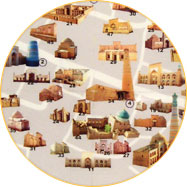|
|
|
Images are depictions. What is not so simple is perceiving an image. We learn to perceive images, that is, to recognize them with understanding, through the filter of cultural experience.  Our cultural values give meaning to both the content of images and their physical form. These values change over time and place and they vary according to the position of the viewer within a society. As a result, the same image can be perceived in alternate ways by people at the same time and can also be valued differently over time. Images travel across time and space and can be interpreted many ways in various cultures at different times, too. Thus, when we analyze an image, historians pay close attention to the image itself, the context within which it was created, and to the many different ways that image may have been understood over time. Our cultural values give meaning to both the content of images and their physical form. These values change over time and place and they vary according to the position of the viewer within a society. As a result, the same image can be perceived in alternate ways by people at the same time and can also be valued differently over time. Images travel across time and space and can be interpreted many ways in various cultures at different times, too. Thus, when we analyze an image, historians pay close attention to the image itself, the context within which it was created, and to the many different ways that image may have been understood over time.
Historians vary in their approaches to analyzing the relationship between an image and its society and thus understanding its meaning. For instance, one of the first steps is to ask questions about how an image was made. What kind of ink or brush was used for a drawing? How was a shape on a ceramic vessel created and at what temperature was the glaze fired? How complex was the loom that wove a figure in a textile? And, how many pixels are necessary for a given quality of a digital image? Answers to these questions and others give information about the various technologies used in a society for making images and the necessary skill for using the technologies. They also can suggest social hierarchies of the medium in which the image is made, such as who had access to various materials and methods of creating images.
Historians also perceive meaning in the social relationships between the makers and uses of the image. We probe the social value of the image as well as its makers, sponsors, and audiences and ask the following kinds of questions: What group in the society made the image? What is the subject of the image? Under what conditions was it made? Who sponsored the making? What is the social status of the people who used it (and of those who could not)? Where was it used and for what purpose—for affirmation? Deception? These questions include gender and sexual identity issues both in historical and contemporary societies.
Other historians seek to understand an image by looking at how it relates to what it represents, its aesthetic properties, and how it functions. Here the meaning of the image and its function are perceived through systems of relationships. Is the image a direct likeness of what it represents? Is it an abstraction? Is the representation a part of the whole, such as a head standing for a body or a tree for a landscape? Does the image stand as a sign or symbol for other cultural values such as religion, ethnicity, political belief, or social status? How does the style of this representation differ from that of similar images and thereby differ in meaning? How do its audiences see it?
By seeking answers to these various questions, historians begin to unpack the larger meaning of an image—that is, the complex ways images make meanings for their audiences at given historical moments. Exploring even some of these questions helps you to develop a deeper understanding of the image you are looking at.

|



